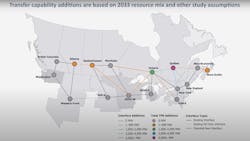NERC’s ITCS Canadian Analysis Finds Increasing Grid Vulnerabilities and Urgent Need for Transmission Upgrades
NERC has published its Interregional Transfer Capability Study (ITCS) Canadian Analysis of transfer capability between transmission planning regions (TPR) and the reliability benefits of enhancing cross-provincial and cross-border transmission.
The analysis, which supports NERC’s ITCS Final Report published in 2024, found that Canadian systems are increasingly vulnerable to extreme weather and transmission limitations. It also identified the potential for energy inadequacy in all of the 12 weather years studied and found that enhancing transmission interfaces are expected to reduce the possibility of energy deficits during extreme conditions.
The study was conducted using a common approach and a consistent set of assumptions. Stakeholder engagement was fundamental for a comprehensive and inclusive study. An Advisory Group was formed, which included regulators, industry trade groups, and transmitting utilities, to ensure that all stakeholders were represented.
“This analysis shows where targeted improvements to transmission infrastructure could further leverage Canada’s significant generation resources to support reliability and resilience across the North American bulk power system.” said John Moura, NERC’s director of reliability assessments and performance analysis.
NERC’s annual seasonal and long-term assessments have identified the need for more transmission, as well as a strategically planned resource mix, to address the ongoing electrification of the economy, including the growing transportation sector, industrial loads, and data centers. These factors emphasize the importance of adequate and informed planning at a broad interregional level to support future grid reliability and resilience.
The ITCS Canadian Analysis demonstrates an opportunity to optimize energy reserve use across multiple TPRs and shows the role of transmission in increasing the use of resources, including energy-limited storage and demand response. Further, the analysis highlights the ongoing importance of holistic transmission and resource planning, as increasing transfer capability without surplus energy is found to be inefficient.
Key Findings:
- Observed transfer capability is generally higher between Canada and the United States but relatively lower between provinces.
- Reliability risks are highly dependent on regional weather conditions. The import capability that could be beneficial during extreme conditions varies significantly across the country. An additional 12–14 GW of transfer capability is expected to be an effective vehicle to strengthen energy adequacy under extreme conditions.
- More recent industry forecasts, reflected in NERC’s 2024 Long-Term Reliability Assessment data, generally resulted in considerable improvement, particularly in Ontario and Quebec, as resource projections meet demand forecasts. Ongoing studies will capture the impacts of future forecast changes.
- A broad set of solutions, including transmission, local resources, demand-side, and storage, should be considered. A diverse and flexible approach allows tailored solutions specific to each province’s vulnerabilities, risk tolerance, economics, and policies.
NERC encourages enhanced collaboration between Planning Coordinators, alignment with federal and provincial policies, and consistent stakeholder engagement to effectively assess, refine, and execute strategies.
